SPIA Member, J.V. Meenakshi, Professor of Agricultural Economics and Health Economics at the Delhi School of Economics, University of Delhi, India, teaches courses in econometrics and food and agricultural policy. In this guest blog, she explains why she sees the recently published report Shining a Brighter Light: Comprehensive Evidence on Adoption and Diffusion of CGIAR-related Innovations in Ethiopia as a textbook example of how to document adoption and diffusion of innovations at scale.
Perhaps like no other comparable set of institutions, CGIAR is held to a high standard of accountability: about whether the innovations that its scientists help create (a) are actually taken up by its stakeholders, if so which, by how many, and (b) make a difference to the livelihoods and lives of those who do adopt these innovations. While many studies attempt to answer some of these questions, they are often small-scale in nature, either in terms of their geographic specificity or in the set of innovations they consider. In contrast, this report is the first of its kind to document answers to the first set of questions at the national level and for the CGIAR System as a whole.
Several features of the report make it distinctive; all features that are worth emulating. These include, but are not limited to:
- Collating and compiling an exhaustive set of innovations that span across crop and animal breeding to natural resource management and policy advice.
- Documenting and justifying the degree to which these innovations can be attributed to CGIAR—noting that the number of innovations with CGIAR input far exceeds the number that were deployed, and explicitly acknowledging the multiplicity of actors it takes to ensure widespread dissemination.
- Methodically choosing appropriate metrics to assess diffusion, based on rigorous research as well as pre-testing of survey instruments. Indeed, the report contributes a great deal to the emerging literature on the role of measurement error in influencing inference even when the methods used are causal. These metrics straddle the entire spectrum from DNA fingerprinting as the benchmark to identify improved varieties, to quantifying often-intangible conservation agriculture innovations.
- Explicitly addressing whether diffusion rates are localized to regions in the physical proximity of CGIAR centers and projects—the report establishes that they are indeed far from being localized with a small number of innovations reaching a significant scale.
- Highlighting the heterogeneity in diffusion, by type of innovation and characteristics of those reached. Apart from the small- versus large- farmer lens to assess equity in access to technology, the report examines how the gender of the plot manager is correlated with adoption of different innovations (adoption of improved poultry being positively correlated with female management, for example)
- Exploiting synergies from collaborations with international and national statistical agencies to produce the evidence base. This report is ample evidence that such collaborations constitute a win-win for all development partners, so long as a high level of logistical, managerial, and technical skills can be brought to bear. The approach the team took is very challenging and is surely not possible everywhere.
I could continue in a similar vein. Rather than moving on to discuss the rich set of conclusions and its implications, let me simply say this: the compilation of evidence reported here is a textbook example of how to document diffusion at scale, and is a quite unique contribution.
Visit the webpage to read the report and find out more.



